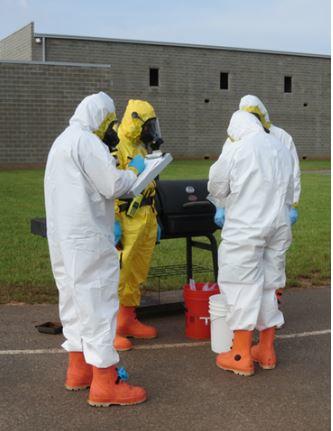Summary
First responders continually receive calls regarding suspicious materials that are potentially biological threat materials. Obtaining high confidence data from biological assessments of suspicious materials in the field remains a challenge. NIST is working in partnership with the Department of Homeland Security Science and Technology Directorate (DHS S&T) to develop methods, guidance, standards, and reference materials to support and improve our Nation's ability to detect and respond to suspected biothreat incidents.
Description

First responders collecting samples of the yeast surrogate material during a field exercise.
Since 9/11 and the subsequent anthrax attacks in 2001, suspicious white powder incidents continue to occur within the US, often requiring Federal law enforcement response. Suspect samples are sent to public health laboratories for confirmatory evaluation, which can take hours to weeks to receive results. A rapid assessment of suspect samples is needed to enable critical on-site decision-making (e.g., should the subway station be evacuated, should shelter-in-place be implemented, etc.). Nationwide protocols vary in technology and resources deployed, and results from any fieldable biological detection technology can have inconsistent quality due in part to the absence of third-party validation. These issues contribute to a lack of confidence in results from fielded detection technologies and limit the routine use of field screening to support decision-making.
NIST is helping to address these issues by developing documentary standards, reference materials, and measurement methods. Overall, this work contributes to the development of a larger infrastructure to increase confidence in fielded biothreat detection and biosurveillance. Moving forward, these efforts will be leveraged in the development of reference materials with greater complexity (e.g., more than one species) to serve as a microbial background and challenge material for emerging detection platforms.
Activities and projects include:
- Documentary standards to support on-site biological assessment and surface sample collection include:
- ASTM E2458-17 Standard Practices for Bulk Sample Collection and Swab Sample Collection of Visible Powders Suspected of Being Biological Agents and Toxins from Nonporous Surfaces
- ASTM E2770-17 Standard Guide for Operational Guidelines for Initial Response to Suspected Biological Agents and Toxins
- ASTM E3095-17 Standard Guide for Surrogate Materials for Field Evaluation of Nucleic Acid-Based On-Site Biological Assessment Technologies
- ASTM WK83732 New Specification for Data Format for Biodetection Instruments for Biosecurity Applications (in progress)
- Surrogate Materials
- A non-threat yeast cell reference material (RM 8230) to support minimal risk training in biological sampling and detection in the field
The Department of Homeland Security (DHS) Science and Technology Directorate supported this work under Interagency Agreements with NIST.

